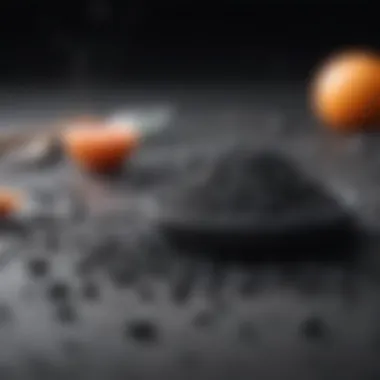Natural Water Filter Materials: Nature’s Purification


Nature Topic Overview
Water is a vital resource for all living things. But not all water is safe to drink. In nature, some materials help purify water. This process is essential for plants, animals, and humans. There are many materials that can clean water effectively. Understanding these materials can help us learn about water filtration and its importance in the environment.
Through this exploration, we will focus on natural materials like sand, gravel, activated charcoal, and natural clay. Each material has unique characteristics that contribute to the purification process. By learning about these natural resources, we develop a greater appreciation for ecological balance and sustainable practices in our lives.
Fun Facts and Trivia
- Did you know that sand is one of the most common materials used in natural water filtration? It effectively traps dirt and impurities!
- Activated charcoal is made when carbon is heated. This amazing material can absorb impurities from water.
- Natural clay can help in water purification. It has tiny particles that catch unwanted substances.
Learning can be fun! You can explore water filtration systems by experimenting with these materials at home.
Wildlife Explorations
Several animals rely on clean water. Fish live in rivers and lakes that depend on natural filtration. Birds often drink from streams that are clear due to filtration by plants and soil.
Also, the plants in these habitats play a crucial role. For example:
- Water lilies provide shade and cool areas for fish.
- Reeds and grasses support wildlife and help keep water clean.
You can enjoy identifying these plants and animals in your nearby parks or natural areas.
Environmental Awareness
Protecting our environment is essential. Clean water supports all life. It's important to conserve nature so that we can continue to have safe drinking water. Here are some ways you can help:
- Use less plastic when you can.
- Recycle to reduce waste.
- Plant trees or flowers in your garden to improve water quality.
Every small step matters in conservation.
DIY Nature Activities
Here are some simple ideas to connect with nature and learn about water purification:
Create a Mini Water Filter
- Collect materials: sand, gravel, and activated charcoal.
- Take a plastic bottle and cut the bottom off.
- Layer the materials in the bottle from bottom to top: charcoal, sand, and then gravel.
- Slowly pour dirty water into the top.
- Observe how the water cleans itself as it passes through the layers.
Outdoor Exploration
When you visit a local park, pay attention to any water sources you see. Look for plants that grow near the water. Discuss how these plants can help clean the water.
By engaging in these activities, you can learn how nature works to purify water and how you can be part of preserving it.
Understanding Natural Water Filtration
Natural water filtration is a vital topic to explore. It concerns how nature itself provides mechanisms to purify water. Understanding natural water filtration caters not only to environmental science enthusiasts but also to children, parents, and teachers. This topic enhances awareness of the ecosystems around us and the resources they offer for sustainable living.
Natural filtration systems utilize materials found in nature. These materials can remove impurities from water, making it clean and safe to drink. By learning about these systems, we can understand better how we can manage water resources responsibly. This understanding also equips us with the knowledge to create eco-friendly water purification methods.
What is Natural Filtration?
Natural filtration refers to the process by which water passes through various materials that naturally collect or break down contaminants. In this context, materials like sand, gravel, and activated charcoal play key roles.
When people refer to natural filtration, they are often talking about how these materials work together in layers. As water moves through different materials, particles and pollutants are trapped. Natural filtration happens in wetlands, rivers, and the ground itself.


Importance of Natural Filtration
Natural filtration is important for numerous reasons. First, it supports ecosystems by maintaining clean water sources. Clean water is crucial for plants and animals. When water is polluted, it affects the entire food chain.
Second, using natural materials for filtration can be more sustainable and less expensive than chemical processes. Families and communities can create their own filtration systems using local materials, which is not only cost-effective but also cultivates a sense of environmental responsibility.
Lastly, natural filtration contributes to understanding how our actions impact the environment. By studying these systems, we can learn about conservation efforts and ways to protect our water systems better.
"Natural filtration systems remind us of how interconnected our ecosystem is and how vital clean water is for all life."
Key Natural Filter Materials
Understanding the key materials utilized in natural water filtration is essential for effective water purification methods. These materials, which include sand, gravel, activated charcoal, and natural clay, each offer unique properties that enhance the filtration process. By learning about these materials, readers can appreciate their ecological roles and consider their benefits in various water filtration systems.
Sand
Sand is one of the most common natural filter materials. It plays a crucial role in separating larger particles from water, acting as a barrier that traps sediments and pollutants. The size of the sand grains influences how well it filters water. Generally, finer sand provides better filtration because it can catch smaller contaminants. This makes sand ideal for both home and community filtration systems.
In addition to its filtering capabilities, sand is abundant and inexpensive. This means it can be easily sourced from local environments, making it a sustainable option. Preparing a sand filter is straightforward; it typically involves layering sand in a container, which allows water to pass through while leaving contaminants behind.
Gravel
Gravel complements sand in the filtration process. It serves several important purposes. First, it helps with drainage, ensuring that water flows smoothly through the filter without becoming stagnant. Larger gravel pieces also support the sand layer above them, creating a stable structure for filtration.
Gravel's effectiveness lies in its ability to capture larger particles in water. This helps protect the finer sand below from becoming clogged too quickly. Due to its porous nature, gravel enables good water flow, which maintains the efficiency of the entire filtration system.
Activated Charcoal
Activated charcoal stands out for its incredible adsorption properties. Unlike sand or gravel, activated charcoal can trap impurities on its surface, effectively removing chemicals, odors, and tastes from water. This material is especially useful in treating water that may have been contaminated with harmful substances, such as chlorine or heavy metals.
The process of activation enhances the porous structure of charcoal, giving it a larger surface area to work with. Incorporating activated charcoal into a filtration system can significantly improve water quality. However, it requires careful management as it can become saturated and lose effectiveness over time.
Natural Clay
Natural clay is another important filter material that offers distinct benefits. It has fine particles that can filter out very small contaminants, including bacteria. The unique property of clay is its cation exchange capacity, which allows it to attract and hold positively charged pollutants, further purifying the water.
In some filtration systems, clay can be combined with other materials such as sand or charcoal to enhance performance. Its natural abundance makes it a viable option, especially in areas where other filtration materials are less accessible. While effective, care must be taken in preparation, as properly compacted clay is necessary to achieve optimal filtration.
By exploring these key natural filter materials, one can realize their significant contributions to effective water filtration. This knowledge can inform decisions in both personal and community projects aimed at sustainable water practices.
The Science Behind Filtration
The science of filtration is essential to understand natural water purification processes. It not only enhances our comprehension of how water is cleaned by different materials but also illustrates the necessity for sustainable practices. Knowledge in this area aids in recognizing the connection between natural ecosystems and water quality. Important elements to note include the methods used in filtration and the characteristics that each material provides in the cleanup process.
Physical Filtration Process
Physical filtration is the first line of defense in water purification. It involves removing larger particles from water as it passes through various materials. For instance, when water flows through a layer of sand or gravel, physical barriers catch larger debris, such as leaves or dirt. This process significantly reduces turbidity, which is clarity of the water.
- Layering: The setup often involves various layers of differing sizes. Each layer captures distinct sizes of particles.
- Gravity: Water moves down through these layers, driven by the force of gravity. This passive movement helps keep the process simple.
- Clogging: Over time, these materials can become clogged with sediments. Regular maintenance is necessary to ensure continued effectiveness.
The physical filtration process is straightforward yet highly effective. It takes advantage of gravity and natural materials to clean water effectively.
Chemical Filtration Procedures
While physical filtration primarily removes solids, chemical filtration addresses the dissolved substances. This process is crucial for eliminating harmful chemicals, bacteria, and viruses from the water. Activated charcoal plays a vital role in this aspect. Its porous nature allows it to adsorb unwanted substances.
- Adsorption: Unlike absorption, where one substance is taken into another, adsorption is when particles adhere to the surface of the charcoal. This effectively cleans water.
- pH Balancing: Some materials can adjust the pH balance of the water. For example, certain clays can interact with acids or bases, leading to more neutral water.
- Biological Processes: In some systems, bacteria break down organic contaminants. The presence of charcoal supports beneficial bacterial growth, making it a more efficient filter material.


The combination of physical and chemical processes provides a robust mechanism for purifying water naturally. Understanding these sciences aids in appreciating how sustainable filtration systems can work, making them practical and effective alternatives to more industrial solutions.
Applications of Natural Water Filters
Natural water filters play a crucial role in providing clean water across various settings. Their applications range from homes to communities and even vital conservation projects. Understanding these practical uses highlights the adaptability and importance of natural materials in promoting health and sustainability.
Home Water Filtration Systems
Home water filtration systems utilizing natural materials offer a sustainable alternative to conventional filters. Many households face issues with tap water due to contaminants. Integrating natural filters can minimize reliance on chemical treatments.
Common methods include:
- Sand Filtration: This method employs layers of sand to trap impurities. Sand is effective in removing rust and particles, making water clearer and healthier.
- Activated Charcoal Systems: Activated charcoal is renowned for its ability to absorb toxins and odors. It significantly improves taste and reduces harmful substances in drinking water.
- Gravel Layering: Gravel serves as a supportive base in filtration systems. It aids in effective drainage and further filters larger particles.
Using these materials is simple and cost-effective. Families can construct their filtration systems, thus embracing a hands-on approach to environmental responsibility.
Community Water Projects
In many regions, water access and quality are major issues. Community water projects that incorporate natural filtration can address these challenges efficiently. These initiatives empower groups to take control of local water sources while promoting health.
Projects often include:
- Constructed Wetlands: These ecosystems filter water naturally through plant roots and soil. They provide habitats for wildlife and help in managing stormwater.
- Bio-Sand Filters: This technology combines sand with a biological layer to treat water. It is effective at removing pathogens without excessive costs.
- Community Gardens: Utilizing natural filtration systems, these gardens not only produce food but also enhance local water quality.
Such projects show the power of collective action in achieving clean water solutions. They also nurture community spirit and encourage environmental stewardship.
Environmental Conservation Efforts
Natural water filters are essential not just for providing clean water but also for supporting broader environmental efforts. They help maintain ecosystems and promote biodiversity.
Key efforts include:
- Habitat Restoration: Restoring wetlands and rivers enhances natural filtration processes. This helps to preserve various species that rely on these habitats.
- Soil Health Improvement: Natural filtration methods improve soil quality, which is crucial for agriculture and prevents runoff into water bodies.
- Education Programs: Communities can engage in educational initiatives to teach about the benefits of natural filtration. This awareness fosters respect for local resources and encourages sustainable habits.
Natural filtration methods exemplify a harmonious relationship between humanity and the environment, offering solutions that are both effective and eco-friendly.
By applying natural water filter techniques in homes, communities, and conservation efforts, we embrace an integrated approach to water management that is sustainable, cost-effective, and beneficial for future generations.
Comparative Analysis of Filter Materials
In the context of natural water filtration, a comparative analysis of filter materials serves as a vital component of this article. It provides a structured evaluation of various materials used in natural filtration systems, examining their effectiveness, cost, and sustainability. Understanding how these materials compare lays the foundation for informed choice in selecting the best approach for water purification.
By analyzing these filter materials, readers can appreciate the significant characteristics that define each one. This analysis also highlights the practical implications of selecting the right material based on specific needs and environmental conditions. Such knowledge is crucial for both individuals and communities aiming for sustainable water solutions.
Effectiveness of Each Material
When it comes to water filtration, not all materials perform equally well. The effectiveness of filter materials can be assessed in terms of their ability to remove impurities, toxins, and other contaminants from water.
- Sand: Sand is recognized for its mechanical filtration capability. It traps larger particles, making it effective for removing sediment from water.
- Gravel: Gravel works similarly to sand but is often used in conjunction with other materials to enhance the filtration process. Its larger size allows for better flow while still capturing particles.
- Activated Charcoal: Known for its absorbent properties, activated charcoal plays a pivotal role in chemical filtration. It effectively removes impurities, odors, and some harmful chemicals from water, making it particularly valuable for home water filters.
- Natural Clay: Clay can act as a filtration agent due to its fine structure. It often helps in settling down impurities and providing cleaner water.
These materials, while effective in their own right, often work best in combination, forming multi-layered filtration systems. This synergy enhances the overall purification process and maximizes the cleanliness of the treated water.
Cost-Effectiveness and Sustainability
Cost-effectiveness and sustainability are essential considerations when analyzing filter materials. Each material varies in terms of initial expense and long-term maintenance.
- Sand and Gravel: Generally inexpensive, sand and gravel can be sourced locally, reducing transportation costs and environmental impact.
- Activated Charcoal: While it may be more costly than sand or gravel, activated charcoal’s long-term benefits in improving water quality often justify the investment. Its regeneration capability also makes it a sustainable choice, as it can be reused multiple times.
- Natural Clay: Clay is also widely available and low-cost. However, its effectiveness may require periodic replacement, which could impact long-term costs.


Sustainability involves not only the material's sourcing but also its impact on the environment. Materials like sand and gravel come from natural deposits, which need to be managed to prevent ecological damage. On the contrary, activated charcoal's production requires more resources, although advances in technology are improving its sustainability.
Understanding both cost-effectiveness and sustainability allows users and planners to make thoughtful decisions when implementing natural filtration systems.
Creating a Natural Water Filter
Creating a natural water filter is a crucial aspect of understanding how to utilize the materials found in our environment for water purification. This topic is vital for anyone interested in sustainable practices, education, and environmental stewardship. Natural filters can provide clean water in various contexts, such as at home and in community projects. By learning about these systems, individuals can gain practical skills that promote ecological health and resource preservation. Such filters also allow users to appreciate the simplicity and effectiveness found in nature's own design.
Step-by-Step Guide
Building a natural water filter can be an engaging project, especially for children, which serves both educational and practical purposes. Below is a simple, step-by-step guide to creating one:
- Gather Materials: You will need sand, gravel, activated charcoal, natural clay, and a container like a plastic bottle or a bucket.
- Prepare the Container: If using a plastic bottle, cut the bottom off to create an opening where the water will flow out.
- Layer the Materials: Start by layering the filter materials in the container. The order should generally be:
- Add Water: Slowly pour the water you want to filter into the container. Make sure to pour it gently so it does not disturb the layers.
- Collect Filtered Water: Allow the water to pass through all the layers, collecting the cleaner water at the bottom.
- Test the Filter: It is essential to check how well the filter works. You can test clarity and smell to determine effectiveness.
- A layer of natural clay at the bottom to trap fine particles.
- A layer of activated charcoal next, which helps remove odors and chemicals.
- Follow this with a layer of sand, which filters out smaller particles.
- Finally, add gravel on top to prevent the upper layers from getting disturbed and to allow water to enter freely.
Through this hands-on activity, children learn not only about the scientific principles behind filtration but also about the significance of clean water.
Safety Considerations
Safety is a critical aspect when engaging with natural water filtration projects. Here are some important points to keep in mind:
- Material Selection: Ensure that all materials are safe and free from harmful chemicals. Non-toxic clay and clean sand and gravel should be used for the filter.
- Clean Water Sources: Always use water samples known to be contaminated for educational purposes. Never use water that is potentially unsafe to drink or handle.
- Supervision Required: Adult supervision is essential when children are involved, especially with cutting materials and handling water.
- Health Precautions: After the filtering process, remind children to wash their hands thoroughly. This prevents any potential transfer of pathogens.
Creating a natural water filter not only establishes a practical understanding of water purification but also emphasizes responsible practices surrounding water resources. Engaging in such activities fosters a greater awareness of our environmental impacts and health.
Future Trends in Natural Filtration
Natural filtration has been evolving in recent years, and its future trends hold great significance for sustainable water purification. Understanding these trends helps us appreciate how advancements can create more efficient systems that harness nature's capabilities. As the demand for clean water rises, innovative ideas emerge, targeting both environmental protection and community health.
Innovations in Filtration Technology
The advancements in filtration technology are essential for maximizing the effectiveness of natural materials. These innovations can enhance the performance of existing filtration systems, making them more suitable for diverse environments.
- Biofilters: These systems integrate living organisms like mosses or biofilm to improve water clarity and quality over time. They rely on natural processes to filter out pollutants.
- Hybrid Systems: Combining traditional materials like sand and activated charcoal with new technologies can improve purification levels. For instance, solar-powered filtration units integrate UV light, killing pathogens in water.
- Smart Sensors: These devices monitor water quality in real-time. They can detect contaminants and inform users to change filters or purifying methods accordingly.
Each innovation reflects a moving away from synthetic chemicals and toward more sustainable solutions integrated with nature's mechanisms.
Potential for Educational Use
Natural filtration offers remarkable opportunities for educational initiatives, especially for children and communities. Understanding how natural materials work to clean water can foster a sense of responsibility toward the environment.
- Hands-On Learning: Schools can employ simple projects. For instance, children can build their own small-scale filters using sand, gravel, and activated charcoal. This practical experience makes concepts of ecology and science tangible.
- Field Studies: Educators can organize field trips to local rivers or wetlands, enabling students to observe natural filtration processes in action. They can see how ecosystems naturally purify water and how human actions impact these systems.
- Interactive Workshops: Organizing community workshops can educate families about the importance of preserving natural water sources. Topics may include the role of plants in water filtration and how to implement home filtration systems using local materials.
Finale: The Value of Natural Solutions
Natural water filtration materials are not just tools, but integral parts of our ecosystem. They offer sustainable ways to purify water, reinforcing the connection between human needs and the environment. Understanding these natural solutions is essential for fostering a balanced ecological relationship.
Summary of Key Points
Natural filtration systems utilize materials like sand, gravel, activated charcoal, and natural clay. Each plays a distinct role in water purification:
- Sand: Acts as a primary physical barrier, intercepting larger particles.
- Gravel: Provides structural support in filtration systems, allowing for water flow.
- Activated Charcoal: Effective in removing impurities and odors, enhancing water taste.
- Natural Clay: Offers fine filtration capability, capturing smaller particles.
These materials work together to create efficient, sustainable systems. Their use promotes environmental awareness, showcasing how nature provides solutions to clean water problems.
Call to Action for Future Learning
It is essential for children, parents, teachers, and caregivers to explore the world of natural water solutions. Engage in activities that build a deeper understanding of how these materials work. You can:
- Visit local environments to observe natural filtration processes.
- Experiment with DIY water filtration projects using available materials.
- Discuss the impact of pollution and the importance of keeping water sources clean.
The knowledge of natural water filtration is not just academic; it can lead to practical applications and environmental stewardship. For further insight, check educational platforms or community resources that focus on sustainable practices.







